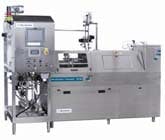Microfluidics will unveil the latest version of its newly standardized Aseptic M-7250CP constant pressure system, a premium Microfluidizer processor for the BioPharm industry, at the Interphex 2007 Conference and Exhibition from April 24-26 in New York, NY. The M-7250CP incorporates new system architecture and is able to integrate machine controls, functions and data recording onto a single common platform.
Standard features include a Yokogawa data acquisition station (DAQ) that continuously monitors temperature, pressure and flow, enabling users to easily and cost-effectively record and print digital testing data. Additionally, the system offers Steam in Place (SIP) for aseptic processing of drugs in a cGMP environment, and Ultra Clean in Place (UCIP) that eliminates the need to disassemble for cleaning between batches or before storage.
A programmable logic controller (PLC) manages on board sensor signals and coordinates audio-visual alarms, operator acknowledgment and motor control interlocks. In the event that an operating parameter is out of tolerance, the embedded controller will manage the signal processing. Additionally, the PLC coordinates these signals in conjunction with the data recorder to provide the customer with an event log detailing testing data. This enhances the batch record-keeping function and aligns with the requirements of GAMP4 guidelines.
The M-7250CP fluid processor achieves a uniform pressure profile. Coupled with its proprietary fixed interaction chambers, the constant pressure system ensures that every unit volume of product is exposed to the same level of shear force resulting in the least number of passes thus maximizing production cost savings.
The constant pressure pumping system incorporates digitally controlled position sensors that automatically adapt to changing requirements and maintains a process pressure profile within +/- five percent of the desired setting. This novel pumping system eliminates pressure spikes, provides uniform processing, extends overall system reliability and reduces the frequency of preventive maintenance cycles.





